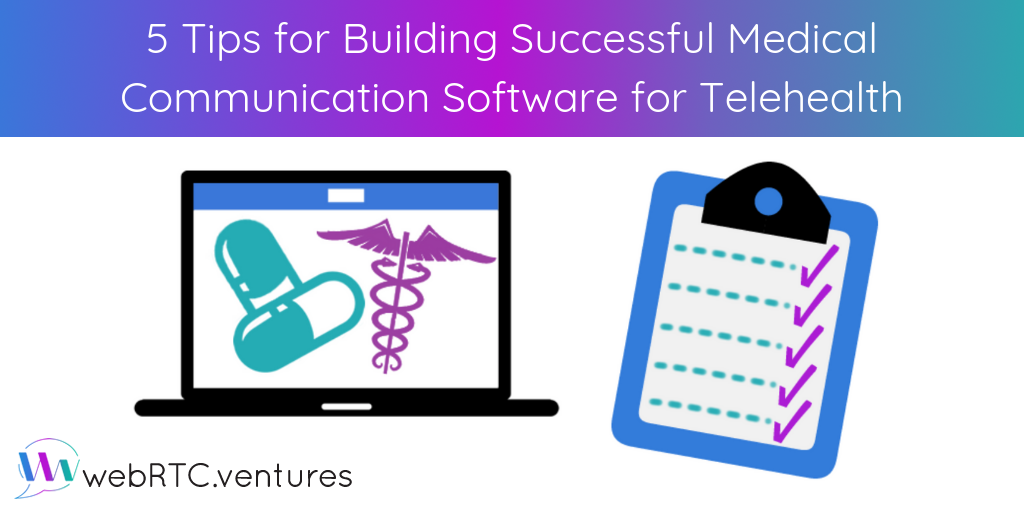It’s no secret that telemedicine is a valuable tool for healthcare providers to increase access and improve their services. There are a lot of benefits of using telemedicine. Here are some of the most important aspects to consider when building a successful medical communication software for your healthcare practice.
Focus on the process
The most important thing is not to focus solely on the technology but on the process.
Sure, technology is cool. It can perform video and audio calls, send real-time notifications, allow you to message with others, and more. But keep in mind that these are only building blocks that should be compounded together by a business model that’s carefully designed around your organization’s needs.
Before adding the utilities provided by real-time technologies, set your objectives, involve all the actors (physicians, nurses, patients, and admins), and build a foundational process that dictates where these technologies will fit and how they will work.
Multi-platform
Once you define your process, it’s time to add the fancy real-time utilities. Consider a multi-platform approach compounded by a group of web, desktop, and mobile applications. Each one should fulfill a specific purpose.
For example, you might have a web application where patients sign in to schedule and initiate remote first-contact or follow-up telehealth voice/video sessions.
After the initial consultation, patients can download a mobile app that alerts them to take medication and gives them custom recommendations according to their records. The app can be also be used by physicians and nurses who check in on their patients in real-time.
A separate desktop app can be used to establish secure chat sessions between patients and physicians.
This is just an example of what you can achieve by integrating several applications into one big medical platform. Of course, it all depends on the needs of your organization. You can choose to start small and then extend the possibilities.
HIPAA-compliance
If you want to provide telemedicine services in the US, your solution must be HIPAA-compliant. Each country has its own regulations for storing and transmitting patients’ health information. Even if it’s not required or regulated, the security required by other countries’ regulations are worth considering.
With HIPAA, there are two important requirements that every compliant application must follow. These are (1) encryption at rest and in transit for protected health information (PHI) and (2) an auditing, backups, and disaster recovery control system.
Encryption means that information is stored and transmitted in a way where a non-authorized user who gains access to the information cannot read it. This is done by encoding the information using an encryption algorithm and a key for decoding.
The auditing, backups, and disaster recovery control system allows system administrators to know who accessed health information and when. It also allows them to create copies of the information for business continuity in case of disaster.
As you can see, it is quite a challenge — but not impossible — to implement HIPAA compliance; however, HIPAA-compliance will make your patients feel secure about how their information is stored and transmitted.
An easy way to start is by using tools from by cloud providers such as Amazon Web Services. They make it easy for customers to provision HIPAA-compliant infrastructure for medical applications.
Patient-side software
It’s a good thing to include patients in the platform by building applications that work on their side. An example is an application that reminds them to take medications, perform exercises, or chat with their provider. The patient will feel more engaged to the suggested treatment plan and is more likely to adhere to it.
Patient-side applications also allow physicians to follow-up with their patients and make sure they are following their treatment plans correctly.
Integration
Allowing the application to integrate with other software and hardware solutions opens a world of possibilities.
Trying to build a one-size-fits-all solution can be a difficult task and may not be worth the cost to you.
Instead, it’s a good practice to develop integration channels with other existing solutions. This keeps the actual medical application as simple as your business model requires.
If your business model considers the use of wearable devices for tracking patients’ vital signs, it may be cheaper and equally effective to use the bundled device’s software and integrate it with your application using REST APIs instead of trying to build a software for the device from zero or build a custom hardware device.
In the same way, it’s highly likely that your application will need to communicate to and from other medical software. Because of this, building a solid integration channel is an important feature to consider.
Interested in learning more?
Click here to learn how a telemedicine WebRTC application can financially benefit your hospital, healthcare system, or practice. You can also read case studies and testimonials and even see a telemedicine app in action.
Ready to build your medical communication application?
Building successful medical communication software is not a trivial task. There is a lot of significant work that requires proper planning, designing, coding, and testing processes. We hope this blog post will help you design the next big thing in telehealth.
OR
Let our experts at WebRTC.ventures help you build your custom video and audio telehealth app. We have decades of experience with over 200,000 hours invested in building real-time applications.
Contact us today. We’ll build your user-friendly, HIPAA-compliant telehealth application — designed with both the provider and patient in mind.




